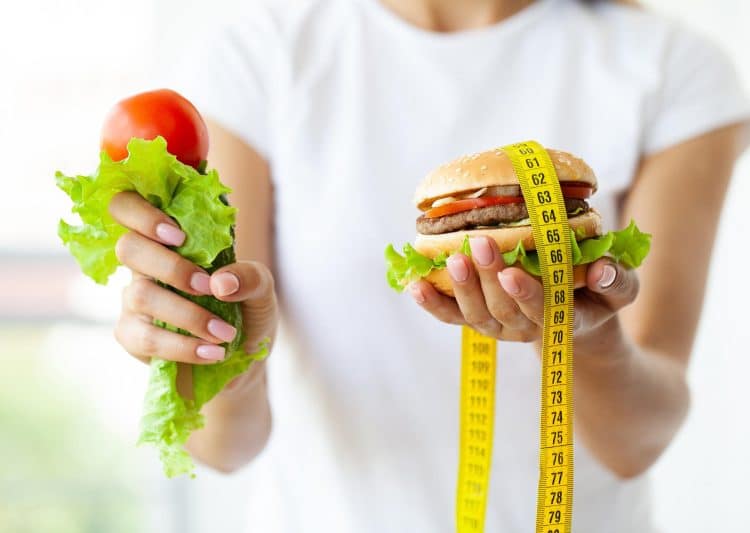With so many dieting patterns, it is difficult to understand which would suit your body type, metabolism, and nutritional requirements. If you are a mindful eater and are still unable to shed those extra kilos, the zig zag diet might be the answer to your problem. A zig zag diet, also called calorie-shifting, involves fixing your diet with high and low-calorie days in a week. (1)
As a health and nutrition expert, I am constantly explaining the benefits of one form of diet over another to my followers. Weight loss is the ultimate concern for most of them. Many complain that they consume few calories and still struggle to lose weight. It happens since your metabolism rate has adjusted to your low-calorie intake, and there is no reason for your body weight to show remarkable changes with the same eating pattern.
You will break your set eating pattern with a zig zag diet plan. In this article, I explain how the zig zag eating plan works and why you would expect weight loss by following it.
Let’s explore the intricacies of the zig zag diet plan, from its fundamentals and set up to the benefits, effects on weight loss, potential downsides, and practical tips for maximizing its effectiveness.
Basics of Zig Zag Dieting
A zig zag diet involves calorie-shifting, where you will eat high and low-calorie diets on specific days in a week. Unlike other diet plans, you do not have to limit your calorie consumption daily. Instead, you will cut a little more calories on a particular day and consume them later in the week in a cyclic pattern.
Level Up Your Fitness: Join our 💪 strong community in Fitness Volt Newsletter. Get daily inspiration, expert-backed workouts, nutrition tips, the latest in strength sports, and the support you need to reach your goals. Subscribe for free!
You can have three low-calorie days and then a high-calorie day and repeat the same pattern. You can alternate the diet with two or three inconsecutive cheat days in a week or whatever works for your lifestyle. There is no fixed recommendation on your calorie intake on low and high-calorie days. However, you must create a calorie deficit on low-eating days and eat just above your daily caloric target on high-calorie days.
The trick is to stop the body from adapting to a low-calorie intake and avoid homeostasis.
You can follow the zig zag diet pattern with a low-carb or keto diet. An intermittent fasting regimen can also enhance the benefits of a zig-zag diet. Eating less over an extended period decreases the body’s metabolic rate. With a zig zag diet, you can expect better weight loss benefits and feel more satiated.
This diet plan’s flexibility makes it attractive to people trying to lose weight. You can eat anything as long as they’re nutritious and align with your calorie targets.
How To Set This Diet Plan Per Your Nutritional Needs?
There are no complex rules on what to eat in a zig zag diet. Your caloric goals will depend on your BMI, activity, and how much weight you intend to lose. Calculate your Basal Metabolic Rate (BMR) based on your current weight and desired weight loss goals to determine your daily calorie intake. No two people will eat the same number of calories or food within a zig zag diet program.
To lose around 2 pounds of fat, you should create a deficit of 7,000 calories. Spread across a week, this means consuming 1,000 calories less each day.
Now, with a calorie-shifting diet plan, you need not cut exactly 1,000 calories each day. By adopting a zig-zag approach, you can adjust to a deficit of 1,200 calories for three days instead of the standard 1,000 calories and then allocate the accumulated buffer of 600 calories (200 calories * 3 days) to your high-calorie day.
In a zig zag diet pattern, most people eat 400-600 calories more on their high-calorie days.
Again, there isn’t a fixed number of calories you should consume on your high-calorie or low-calorie days. You do not have to stick to a specific limit as long as you do not overindulge in food. Studies on the impact of alternating high and low-calorie intake within time-restricted feeding suggest that a continuous calorie restriction isn’t necessary to preserve your metabolic circadian rhythm. (2)
Planning your diet in advance and setting a broad calorie limit for low and high-calorie days can boost your weight loss results. Adopting this strategy helps maintain your weight loss trajectory by preventing overeating.
Benefits of Zig Zag Dieting Among Other Meal Plans
A zig zag diet suits many, as you can eat whatever you like while adhering to your fitness goals. Typical diets deprive you of your favorite high-calorie foods for a long time, making them unsustainable. Let us check out how a zig zag diet works better.
Gives Enough Food Variety
With a zig zag diet, you can eat high-calorie foods on specific days of the week. You are not restricted to consuming the same foods daily and can experiment with different foods.
Feels More Satiating
Since you are not always starving on this diet, you feel more satiated and full of energy. If battling hunger and a penchant for high-calorie treats leaves you fatigued and moody, this diet plan ranks among the best options for you.
Sustainable
A zig zag diet does not require you to make outright extreme changes, which you might do with a keto or an egg diet. The idea is to eat sustainably so you do not feel like you are missing out on anything. Studies show a calorie-shifting diet is easier to follow than restricting calories altogether. (3)
It is a more sustainable approach and can be done for the long term, and that is mostly not true for other diets such as keto, paleo, and banana diet. Once you have followed a zig zag diet for a considerable period, you may naturally develop mindful eating habits, seamlessly blending the concept of ‘dieting’ with your everyday eating routine.
Cross the Weight Loss Plateau
The zig zag diet might help break through your weight loss plateau. A sudden influx of calories will reset your system for optimal performance. You can better preserve your lean body mass and still be able to lose weight with a zig zag diet.
Level Up Your Fitness: Join our 💪 strong community in Fitness Volt Newsletter. Get daily inspiration, expert-backed workouts, nutrition tips, the latest in strength sports, and the support you need to reach your goals. Subscribe for free!
Research indicates adaptive thermogenesis reduces metabolic rate, diminishes fat loss, and lowers energy output. This occurs as the body enters survival mode due to frequent periods of reduced food intake. (4)
Does This Diet Plan Work For Your Weight Loss?
Research indicates that calorie cycling and subsequent refeeding were more effective in weight loss than a traditional calorie-restricting diet. However, more research is warranted in this field. (4)
Another study had an interesting inference for people who consume coffee/tea and follow a zig zag diet. It showed better weight loss than people who followed a pure calorie-cycling diet. (5)
Weight loss depends on your food choices, lifestyle factors, and metabolism. I recommend working with a certified nutritionist to understand how to tune a zig zag diet to your weight loss goals.
When Can A Zig Zag Diet Backfire?
This diet’s flexibility can sometimes prove counter-intuitive. That is because people have difficulty restricting calories on high-calorie days. You might end up overstuffing and reckless binge eating, which defeats the purpose of a weight-loss diet.
Also, a zig zag diet is more challenging than a fixed-calorie diet. It is because people tend to lax on their high-calorie eating day, ending up eating a lot more.
The zig-zag diet is designed to steadily condition the mind towards choosing nutritious foods. You should eat healthy regularly and make healthy food choices even when eating out. If you do not do that and take the diet too lightly, it might give you the desired results.
Moreover, making unhealthy food choices on your cheat days can lead to health issues. You should use these days to eat enough healthy and nutritious food so your body can benefit from essential vitamins and minerals that are missing in the calorie-restricted diet on other days.
Also, if you lose a lot of weight quickly by excessively cutting calories, you might regain the lost weight when you start eating normally.
How To Get the Best Out of Your Zig Zag Diet?
The first thing to know when starting with a zig zag diet is the calories you need to sustain yourself. Based on that, you must plan your meals and make food choices. Here is what will help you make the most of this diet plan:
Understand Your Caloric Needs
Use a calorie calculator to know how many calories your body needs to design your zig zag eating pattern. Avoid overstuffing on high-calorie days if your caloric specifications are already met.
Plan Your Meals
You should have a plan on how many calories you will eat on your low and high-calorie days. Try including vitamins, minerals, antioxidants, and fiber in your diet. Ensure you eat a nutritious and balanced meal.
Choose Healthy Food
For any kind of weight loss diet, you should avoid high-carb, high-cholesterol foods. Prefer non-starchy veggies such as spinach, Brussels sprouts, and mushrooms over potatoes and corn. Also, avoid foods with saturated and trans fats, like processed meats and French fries. Ice creams, colas, and candies never help in a weight loss regime.
Be more creative with your food and prefer healthy alternatives like whole wheat bread, whole grains, low-fat dairy, and brown rice instead of processed carbs.
Avoid Binge Eating
The snacks you eat between meals are the hidden culprits that mess with a weight loss plan. Empty calories from sugary drinks, alcohol, etc., disrupt your system big time. Avoid such unhealthy foods.
FAQs
Can a zig zag diet help me balance my blood sugar levels?
Yes, a zig zag diet involves high and low-calorie eating intervals that cushion the fall and spikes in blood sugar. However, before beginning any diet, please consult a medical practitioner, especially if you are dealing with pre-existing health conditions.
How many calories can I eat in a zig zag diet on high-calorie days?
You should consult a dietician to form a weekly calorie plan according to your weight loss expectations and current body composition. You can divide the required calorie amounts into high and low-calorie days.
Is a zig zag diet safe?
Yes, following a zig zag diet is completely safe as long as you eat a balanced meal with leafy vegetables, lentils, proteins, and carbohydrates. However, if you have medical conditions like diabetes or other eating disorders, this diet might not be the best for you.
Can I lose weight with a zig zag diet?
Yes, if you successfully create an overall calorie deficit while cycling your calories, you can sustainably lose weight with a zig zag diet.
Conclusion
The zig zag diet involves switching between high and low-calorie days. While the diet doesn’t set strict calorie intake guidelines, working with a dietitian is advisable to make an informed estimate.
The zig zag diet boosts the metabolic rate, which can help prevent a weight loss plateau. It is more sustainable, gives you enough food variety to experiment with, and keeps you emotionally stable and happy. Choose a healthy mix of foods that abide by your macro and micronutrient goals to avoid nutritional deficiency.
References:
- Davoodi, S. H. (2014, April 1). Calorie Shifting Diet Versus Calorie Restriction Diet: A Comparative Clinical Trial Study. PubMed Central (PMC). https://www.ncbi.nlm.nih.gov/pmc/articles/PMC4018593/
- García-Gaytán, A. C., Miranda‐Anaya, M., Turrubiate, I., Portugal, L. L. D., Bocanegra-Botello, G. N., López-Islas, A., Díaz‐Muñoz, M., & Méndez, I. G. (2020, June 22). Synchronization of the circadian clock by time-restricted feeding with progressive increasing calorie intake. Resemblances and differences regarding a sustained hypocaloric restriction. Scientific Reports. https://doi.org/10.1038/s41598-020-66538-0
- Davoodi, S. H. (2014, April 1). Calorie Shifting Diet Versus Calorie Restriction Diet: A Comparative Clinical Trial Study. PubMed Central (PMC). https://www.ncbi.nlm.nih.gov/pmc/articles/PMC4018593/
- Heinitz, S., Hollstein, T., Ando, T., Walter, M., Basolo, A., Krakoff, J., Votruba, S. B., & Piaggi, P. (2020, September 1). Early adaptive thermogenesis is a determinant of weight loss after six weeks of caloric restriction in overweight subjects. Metabolism. https://doi.org/10.1016/j.metabol.2020.154303
- Davoodi, S. H. (2014, January 1). Caffeine Treatment Prevented from Weight Regain after Calorie Shifting Diet Induced Weight Loss. PubMed Central (PMC). https://www.ncbi.nlm.nih.gov/pmc/articles/PMC4157047/
Article Updates Timeline:
Our editorial team experts constantly update the articles with new information & research, ensuring you always have access to the latest and most reliable information.
February 21, 2024
Written By
Dr. Rashmi Byakodi
Updated By
Vidur Saini
Reviewed By
Editorial Team
Fact Checked By
Dr. Steven Griffin











